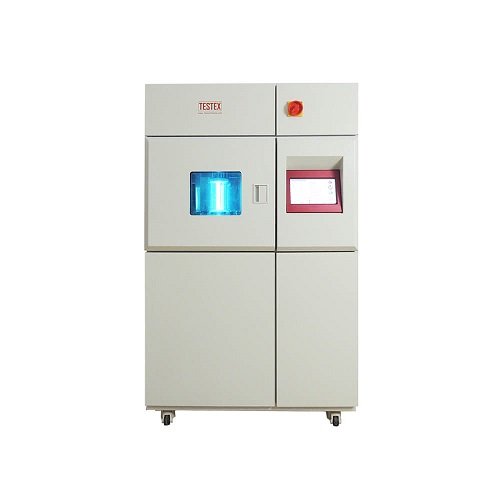In the textile industry, where quality and durability are paramount, light fastness is one of the key attributes that determine the longevity and aesthetic appeal of fabrics. Light fastness refers to the ability of a material—especially dyed or printed textiles—to retain its original color when exposed to light, particularly ultraviolet (UV) light, over a prolonged period. Fabrics that lose their color rapidly when exposed to light can become unappealing to consumers and lead to significant economic losses for manufacturers. The Light Fastness Tester is an essential tool in textile testing that helps assess how resistant fabrics are to fading when exposed to light, thus ensuring that products meet industry standards and consumer expectations.
The Science Behind Light Fastness Testing
Light fastness testing is crucial because the degradation of colors in textiles due to light exposure is a complex process. Ultraviolet (UV) light, which is part of the sunlight spectrum, is particularly harmful to dyes and pigments used in textiles. When textiles are exposed to UV light, the energy from the light can break down the molecular structure of the dye molecules, leading to fading or discoloration.
There are two main types of light that affect textiles:
- Visible Light: The light visible to the human eye, typically between 400 nm to 700 nm wavelengths.
- Ultraviolet (UV) Light: Wavelengths shorter than visible light, typically below 400 nm, which are more energetic and can cause more damage to dyes and fabrics.
Light fastness testing involves simulating prolonged exposure to natural or artificial light, usually through a Xenon lamp or other light sources that mimic sunlight. The Light Fastness Tester subjects the textile to intense light for a set period of time to observe any changes in color, which are then compared to a standard scale.
The Light Fastness Scale
Light fastness is measured using a numerical scale, typically ranging from 1 to 8, where:
- 1 represents very poor light fastness (the material fades quickly),
- 8 indicates excellent light fastness (the material shows minimal fading).
The scale is determined based on a comparison between the sample fabric and a standard reference under controlled light exposure. The higher the number, the better the fabric’s ability to retain its color over time.
Why Light Fastness Testing is Crucial in Textile Manufacturing
- Consumer Satisfaction
The primary concern for manufacturers is consumer satisfaction. Consumers expect their clothing, furniture, or other textile products to maintain their color and appearance even after prolonged exposure to sunlight. For instance, outdoor furniture fabrics or car upholstery often face long hours of sunlight exposure, which can cause fading if not properly treated. A fabric with poor light fastness can lead to dissatisfaction, damage the brand’s reputation, and result in returns or warranty claims.
- Regulatory Compliance and Industry Standards
Textile manufacturers must adhere to various national and international standards related to light fastness. Regulatory bodies and standardization organizations like ISO (International Organization for Standardization) and AATCC (American Association of Textile Chemists and Colorists) set guidelines for acceptable levels of light fastness for different types of textiles. In certain industries, such as automotive textiles, children’s clothing, and home furnishings, light fastness is a crucial parameter that is closely monitored. Failure to meet these standards could lead to legal repercussions, product recalls, and financial penalties.
- Durability of Printed and Dyed Fabrics
The colorants used in textiles—whether they are natural dyes or synthetic pigments—are susceptible to environmental factors, particularly light. While natural dyes are often more susceptible to fading, modern synthetic dyes also experience degradation when exposed to prolonged UV light. The Light Fastness Tester helps manufacturers assess how well different dyes withstand these conditions. This ensures that textile products, such as fashion garments or upholstery fabrics, retain their appearance after repeated exposure to light. Products with poor light fastness may fade quickly, shortening their lifespan and reducing their overall value.
- Brand Reputation and Market Competitiveness
In the highly competitive textile market, companies that offer high-quality, durable products gain a significant advantage. A fabric that retains its color over time is a sign of good quality, which can help build consumer trust. On the other hand, a brand that sells products with inferior light fastness may quickly lose customer loyalty. As such, light fastness testing is a critical step in quality control, allowing manufacturers to produce textiles that meet or exceed industry standards for color durability. Companies that invest in high-quality dyes and advanced light fastness testing are likely to have a competitive edge in the market.
- Sustainability and Environmental Considerations
In recent years, there has been growing concern about the environmental impact of textiles. Fading textiles require more frequent replacement, which contributes to waste and the environmental burden. By ensuring that fabrics have high light fastness, manufacturers can produce more durable, long-lasting products that are less likely to be discarded due to color degradation. This supports the broader sustainability goals of reducing waste and increasing the lifespan of textile products.
The Role of the Light Fastness Tester in the Testing Process
The Light Fastness Tester is a key instrument in performing these tests accurately and efficiently. The tester typically consists of a light source that mimics natural sunlight, a chamber to hold the fabric sample, and a mechanism for rotating the sample to ensure uniform exposure. The test is often conducted over a period of several hundred hours, depending on the desired level of testing, and the results are evaluated by comparing the exposed sample with a reference color sample using a standard grading scale.
Conclusion
The importance of light fastness testing in the textile industry cannot be overstated. As consumer expectations for quality and durability continue to rise, light fastness becomes a critical factor in ensuring long-lasting products. By utilizing a Light Fastness Tester, textile manufacturers can ensure that their products meet industry standards, maintain their aesthetic appeal, and satisfy consumer demands for high-quality, durable fabrics.

